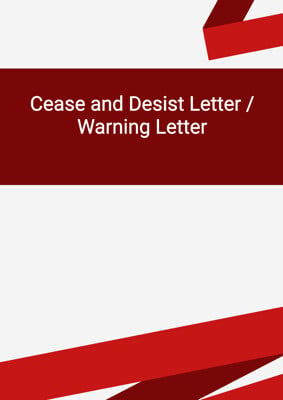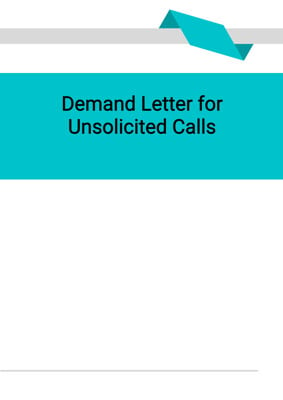
Cease and Desist Letter
Debt Collection Agency
This document can be used to draft a sampled Template Cease and Desist Letter to a harasser who has continuously harassed the victim. This letter is in favour of the victim within the harassment to warn the Debt Collection agency to stop the workplace harassment actions or face legal actions by the dissatisfaction.
How to Tailor the Document for Your Need?
01
Create Document
Click "Create Document" button and the document will be prepared with your account details automatically filled in.
02
Fill Information
Please fill in any additional information by following the step-by-step guide on the left hand side of the preview document and click the "Next" button.
03
Get Document
When you are done, click the "Get Document" button and you can download the document in Word or PDF format.
04
Review Document
Please review the document carefully and make any final modifications to ensure that the details are correct before sending to the addressee.
Document Preview
Document Description
The Cease and Desist Letter is a document that is used to formally demand an individual or organization to stop engaging in certain actions, specifically harassment. This document is important as it serves as a legal notice to the recipient, informing them of their unlawful actions and the consequences they may face if they do not comply.
The entire document consists of several sections that provide detailed information and instructions. The first section includes the account information of the sender, such as their last name, first name, and email address. This ensures that the recipient can easily identify the sender.
The next section is the introduction, which addresses the recipient and states the purpose of the letter. It clearly states that the sender is issuing a final cease and desist letter regarding the unwelcome communication and harassment actions that have been directed towards them, as well as their family and friends.
The document then proceeds to outline the specific allegations of harassment that the sender has experienced. It emphasizes that the recipient must immediately cease these unlawful actions, as they violate the sender's rights under the law. The sender also mentions the damages they have suffered as a result of the harassment.
Furthermore, the letter highlights the sender's knowledge of their rights and the legal consequences that the recipient may face if they continue to harass. It warns the recipient that if they do not confirm in writing by a certain date that they will cease the harassment, a lawsuit will be initiated.
The sender also notifies the recipient that if they fail to comply with the request, a complaint will be filed with the relevant regulatory bodies and the attorney general's office. The sender keeps accurate records of all correspondence and warns that civil and criminal claims will be pursued if the harassment continues. The sender reserves the right to take further legal actions and seek all available remedies against the recipient.
The final section of the document is the schedule, which serves as a record of the harassment incidents. It includes the date, time, and a description of each incident. This section further strengthens the sender's case and provides evidence of the recipient's actions.
In summary, the Cease and Desist Letter is a crucial document that demands the recipient to immediately stop their harassment actions. It provides a detailed account of the sender's experiences, warns of legal consequences, and emphasizes the sender's rights and remedies.
How to use this document?
1. Gather account information: Collect the last name, first name, and email address of the sender. This information will be used to identify the sender in the letter.
2. Introduce the purpose: Address the recipient and clearly state that the letter is a final cease and desist letter regarding the unwelcome communication and harassment actions.
3. Outline allegations: Provide a detailed description of the specific allegations of harassment that the sender has experienced. Emphasize that these actions violate the sender's rights under the law.
4. Demand immediate cessation: Clearly state that the recipient must immediately cease the unlawful actions of harassment. Mention the damages suffered by the sender as a result of the harassment.
5. Highlight legal consequences: Inform the recipient of the legal consequences they may face if they continue to harass. Warn that a lawsuit will be initiated if they do not confirm in writing by a certain date that they will cease the harassment.
6. Notify regulatory bodies: State that a complaint will be filed with the relevant regulatory bodies and the attorney general's office if the recipient fails to comply with the request.
7. Record incidents: Include a schedule section to record the date, time, and description of each harassment incident. This will serve as evidence of the recipient's actions.
8. Warn of further legal actions: Warn the recipient that civil and criminal claims will be pursued if the harassment continues. Reserve the right to take further legal actions and seek all available remedies against the recipient.
9. End with a sincere closing: Conclude the letter with a sincere closing, reiterating the sender's determination to seek justice and cease the harassment.
10. Keep accurate records: Maintain accurate records of all correspondence from the recipient. These records will be crucial in supporting any future legal actions.
Not the right document?
Don’t worry, we have thousands of documents for you to choose from:





